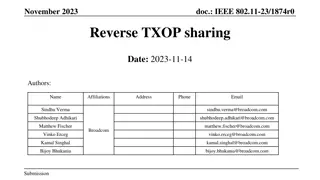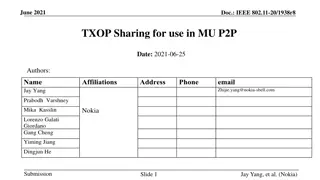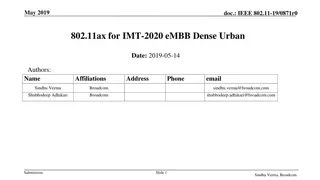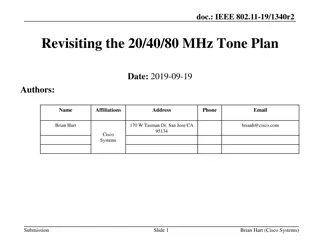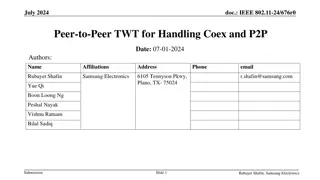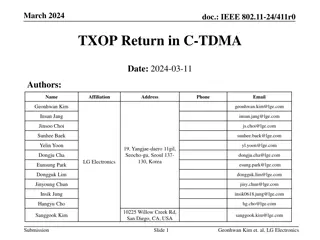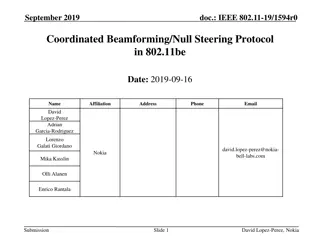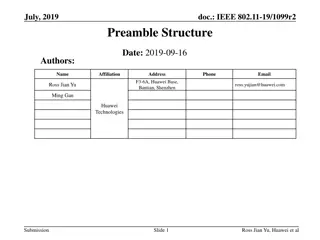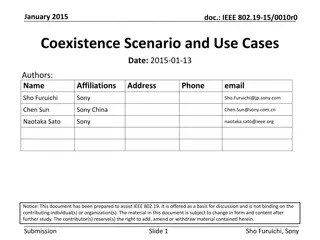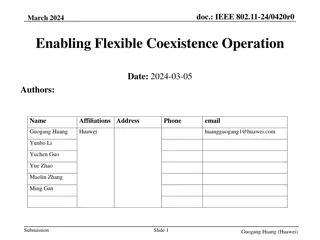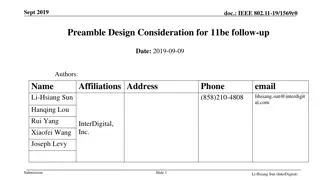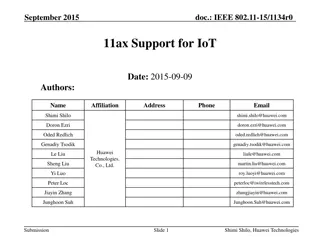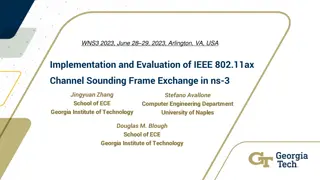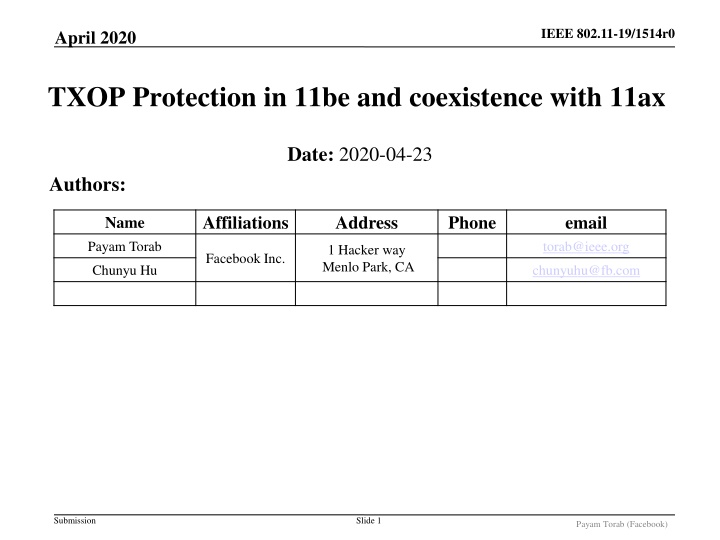
TXOP Protection in IEEE 802.11be and Coexistence with 11ax
Explore proposals for MAC-level mechanisms to protect TXOP in IEEE 802.11be, focusing on PPDUs with bandwidth >160MHz and preamble puncturing. Understand the impacts on 11ax devices and discover design principles to mitigate performance issues in past, present, and future generations.
Download Presentation

Please find below an Image/Link to download the presentation.
The content on the website is provided AS IS for your information and personal use only. It may not be sold, licensed, or shared on other websites without obtaining consent from the author. If you encounter any issues during the download, it is possible that the publisher has removed the file from their server.
You are allowed to download the files provided on this website for personal or commercial use, subject to the condition that they are used lawfully. All files are the property of their respective owners.
The content on the website is provided AS IS for your information and personal use only. It may not be sold, licensed, or shared on other websites without obtaining consent from the author.
E N D
Presentation Transcript
IEEE 802.11-19/1514r0 April 2020 TXOP Protection in 11be and coexistence with 11ax Date: 2020-04-23 Authors: Affiliations Address Phone email Name Payam Torab torab@ieee.org 1 Hacker way Menlo Park, CA Facebook Inc. Chunyu Hu chunyuhu@fb.com Submission Slide 1 Payam Torab (Facebook)
IEEE 802.11-19/1514r0 April 2020 Introduction There are 11be proposals for MAC-level mechanisms to protect TXOP for PPDUs with bandwidth > 160MHz and/or PPDUs with preamble puncture o MAC-level mechanisms involve changes to RTS, MU-RTS and CTS frames and NAV set/reset procedures o Related contributions and straw polls (Section 3.3 (TXOP) in [4]), Do you support that 11be defines a MAC mechanism to protect TXOP for PPDUs with [bandwidth] >160MHz and/or PPDUs with preamble puncturing? [20/0062r0 (Protection with more than 160MHz PPDU and puncture operation, Liwen Chu, NXP][1] Y/N/A/No answer: 41/5/17/31 Do you support to transmit the MU-RTS/RTS and CTS frames in a non-HT duplicate PPDU on 20 MHz subchannels which are not punctured? [19/2125r2 (EHT RTS and CTS procedure, Yongho Seok, MediaTek][2] Y/N/A/No answer: 35/2/18/26 We discuss performance impact of new MAC-level mechanisms, the way they are currently formulated, on 11ax devices We also propose two design principles to avoid performance impact on 11ax (past/present) as well as future (post 11be) generations Submission Slide 2 Payam Torab (Facebook)
IEEE 802.11-19/1514r0 April 2020 Existing TXOP protection mechanisms in MAC RTS/CTS/DATA/ACK or CTS/DATA/ACK o NAV set/reset rules per 10.3.2.4 (Setting and resetting the NAV) (discussed later) o NAV operation Single NAV 11a/b/g/n/ac devices Two NAV 11ax devices (mandatory for non-AP, optional for AP) Sounding frame sequence o NDPA/NDP/SFB : introduced in 11ac o NDPA/NDP/Trigger/ : introduced in 11ax o TXOP honored by 11ac/ax devices accordingly Trigger/HE-TB/ACK: introduced in 11ax MU-RTS/CTS for DL-MU: introduced in 11ax o MU-RTS is a special trigger frame o NAV protection is trickier/weaker, as CTS is transmitted in form of simultaneous-CTS o NAV setting follows RTS/CTS rule Submission Slide 3 Payam Torab (Facebook)
IEEE 802.11-19/1514r0 April 2020 MAC-level protection proposals under discussion Approach to define new frame variants [1] [1] New (Enhanced) RTS, CTS and possibly NDPA frames through an Extended Control subtype value [1] Note: New Extended Control subtype in [1] not to be confused with Control Frame Extension subtype (6), which reuses Frame Control bits 8-11 for additional control frames (all DMG currently). It is however possible to define subtype 6 (and derivative new control frames) differently in 5 and 6 GHz, which allows defining up to 16 new control frames without consuming a new subtype value (and optionally without an additional Extended Subtype field). (Extended Control) Frame Control field of Extended Control frame 1 Extended Subtype Control Information That is, make current Table 9-2 DMG-specific and create a similar table for lower bands. [1] Extending newer control frames (NDP Announcement, Trigger) to realize Enhanced RTS/CTS (using a reserved AID for example) Submission Slide 4 Payam Torab (Facebook)
IEEE 802.11-19/1514r0 April 2020 MAC-level protection proposals under discussion Using new frames to signal preamble puncturing [2] [2] New (enhanced) RTS and CTS frames with punctured channel information o EHT MU-RTS carries a Disallowed subchannel bitmap subfield to indicate subchannels/channels on which the EHT MU-RTS frame is not sent/duplicated o Non-AP STA disallowed to transmit CTS over disallowed subchannel(s) EHT RTS frame format Frame Control Duration RA TA Punctured Channel Information FCS 2 octets 2 octets 6 octets 6 octets TBD 4 octets EHT CTS frame format Frame Control Duration RA Punctured Channel Information FCS 2 octets 2 octets 6 octets TBD 4 octets Submission Slide 5 Payam Torab (Facebook)
IEEE 802.11-19/1514r0 April 2020 11ax performance with new mechanisms Unrecognized RTS and NAV reset rules NAV reset rules in baseline (10.3.2.4) allow a non-target STA that receives the RTS/MU-RTS to reset its NAV if no PHY-RXSTART detected within a short (<< TXOP duration) timeout period after RTS NAVTimeout = 2 aSIFSTime + CTS_Time + aRxPHYStartDelay + 2 aSlotTime If 11ax STAs do not recognize the new RTS frame (or the new MU-RTS frame, in case one is defined), they will not have the option of resetting their NAV in the absence of PHY-RXSTART within the timeout period TXOP Duration New RTS (or MU-RTS) 11be STA CTS Earliest time device can reset its NAV Observing 11be STA (non-target) NAVTimeout O(102) sec Earliest time device can reset its NAV Observing 11ax STA (non-target) TXOP Duration O(104) sec Submission Slide 6 Payam Torab (Facebook)
IEEE 802.11-19/1514r0 April 2020 TXOP protection design suggestions Frame formats 1) Define extensible formats for RTS, CTS and MU-RTS for all current/future devices to understand 2) In the case of 11ax, make the new formats applicable to HE, under a capability to be defined o For example, Extended Capabilities element (9.4.2.26) There is no reason for a MAC-level TXOP protection mechanism not to be applicable to HE (in fact, that s another benefit of a MAC-level mechanism) Fairness with 11ax (with regards to TXOP protection for this presentation) is not a matter of legacy support given where 11ax is today in IEEE (unapproved draft), and in industry (certification program launched less than a year ago) Submission Slide 7 Payam Torab (Facebook)
IEEE 802.11-19/1514r0 April 2020 Proposal Make all MAC-level TXOP protection mechanisms introduced in 11be (including changes/extensions to RTS, MU-RTS and CTS frames and procedures) o Compatible with future generations (i.e., rich/extensible packet formats) Similar approach as the U-SIG design in EHT preamble o Compatible with (understood by) 11ax (under a capability) For new/enhanced RTS/MU-RTS/CTS frames, o Define a common extensible format for each, early on o Leave additional details and refinements to further 11be design o Make the frames and procedures applicable to HE under a capability Amending 11ax draft, or defined in 11be Submission Slide 8 Payam Torab (Facebook)
IEEE 802.11-19/1514r0 April 2020 Straw Poll 1 Do you support defining new MAC-level mechanism for TXOP protection in 11be as HE capability? o Yes: o No: o Abstain: Notes Examples of MAC-level mechanisms include modified or new RTS, MU-RTS and CTS frames, and NAV set/reset procedures to the extent that they are independent of EHT PHY header A feature can be defined as an HE capability through using bits/fields in HE Capabilities element (9.4.2.247), Extended Capabilities element (9.4.2.26), or similar fields/elements accessible to HE STAs Submission Slide 9 Payam Torab (Facebook)
IEEE 802.11-19/1514r0 April 2020 Straw Poll 2 Do you support requiring formats for new RTS, MU-RTS and CTS frames (if defined) to be forward compatible? o Yes: o No: o Abstain: Notes One examples of forward compatibility is using a version field; see 802.11-19-1519/r5 for forward compatibility discussion Combination of Straw Polls #1 and #2 means forward compatibility to start from 11ax, but for 11ax as optional (capability) Submission Slide 10 Payam Torab (Facebook)
IEEE 802.11-19/1514r0 April 2020 Straw Poll 3 Do you support defining new control frames in 11be using the existing Control Frame Extension subtype (6) and using bits 8-11 in Frame Control field? o Yes: o No: o Abstain: Notes This means different definitions for control frames under Control Frame Extension subtype (6) in 2.4/5/6 GHz and in 60 GHz Submission Slide 11 Payam Torab (Facebook)
IEEE 802.11-19/1514r0 April 2020 References 1) IEEE 802.11-20/0062/r0, BW Negotiation, TXOP Protection with >160MHz PPDU and Puncture Operation 2) IEEE 802.11-19/2125r1, EHT RTS and CTS Procedure 3) IEEE 802.11-20/0399r0, BW Negotiation, TXOP Protection with >160MHz PPDU and Puncture Operation 4) IEEE 802.11-20/0566r1, Compendium of straw polls and potential changes to the Specification Framework Document Submission Slide 12 Payam Torab (Facebook)

